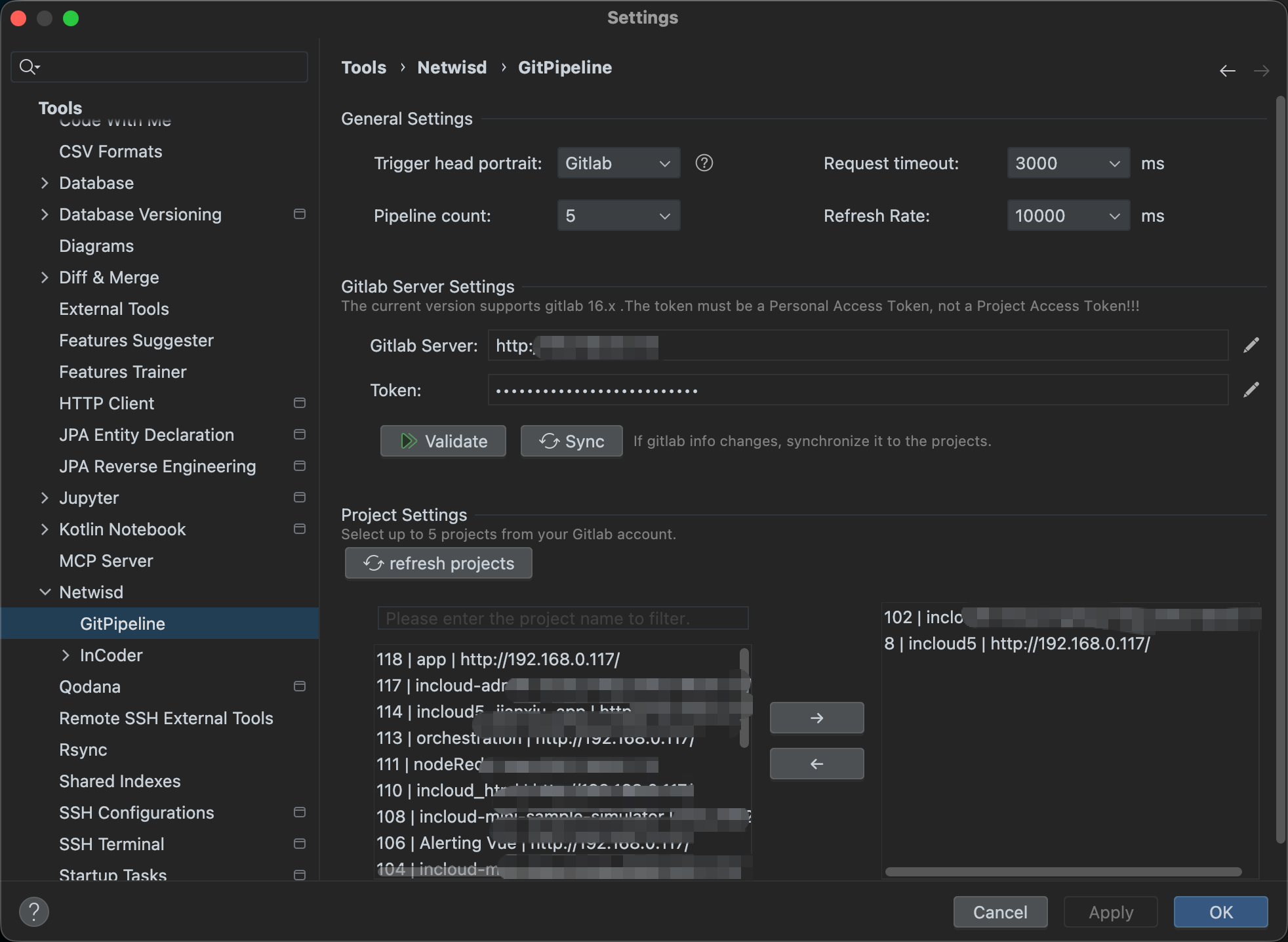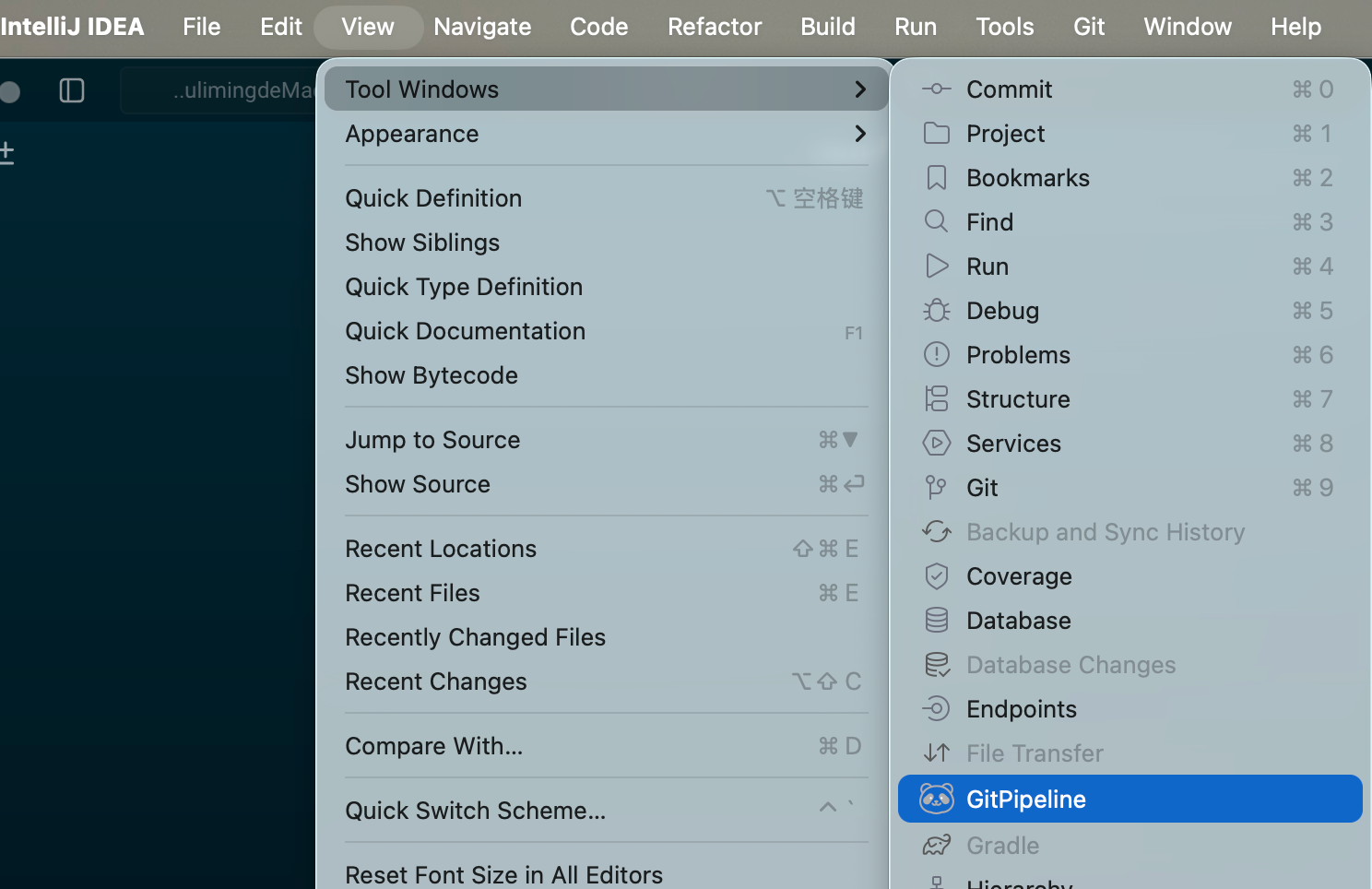GitPipeline English
GitPipeline is a lightweight IDE plugin developed by Netwisd, designed for visualizing GitLab CI/CD pipelines directly inside your JetBrains IDE. It helps developers quickly understand the build and deployment status of their projects without switching to a browser.
Important note:
GitPipeline does not replace GitLab CI/CD. Instead, it enhances your workflow by providing a faster and more convenient way to view pipeline information inside the IDE.
With GitPipeline, you can easily access:
Pipeline status overview
Stage and job details
Live job logs
Real-time progress updates
Prerequisites
Self-hosted GitLab 16.x
GitLab Personal Access Token (for data access)
Supported IDE version: 2025.2.x and above
Installation
Plugin Market
Search for "GitPipeline" in the IDE's plugin market and click Install.
Settings
Open the IDE Settings panel in Tools -> Netwisd -> GitPipeline set item, click to enter the setting page.

General Configuration
The general settings include some basic configurations.
Avatar
There are three options for the avatar:
None: Do not display an avatar
Random: Randomly display a built-in system avatar
Gitlab: Display the avatar from Gitlab
The default is None for the best performance. If you want to see avatars, you can choose Random or Gitlab, but this will increase the performance consumption.
Especially for Gitlab, as it needs to fetch avatars from the Gitlab server, it may cause IDE lag if your network environment is poor. It's not recommended to use it. If necessary, consider setting a smaller number for pipeline items to reduce the number of requests. Also, configure the refresh rate and request timeout to reduce the likelihood of failed requests.
Request Timeout
Request timeout refers to the time limit for fetching data from the Gitlab server. If your network environment is poor, you might want to increase this value, but it's not recommended
to set it too long as it affects user experience. The default is 3 seconds, and it's recommended to use the default value.
Number of Pipeline Items
The number of pipeline items displayed on the homepage each time. If your project has many pipelines, you might want to increase this number, but it's not recommended to set it too high as it affects performance. The default is 5 items, and it's recommended to use the default value.
Refresh Rate
The refresh rate refers to the time interval for Pipelines to fetch data from the Gitlab server on the homepage. If your network environment is poor, you might want to increase this value. The default is 10 seconds, and it's recommended to use the default value.
Gitlab Information Maintenance
Maintain two fields: Gitlab address and token. The Gitlab address must be a valid, accessible URL starting with http or https, such as: http://gitlab.newwisd.com. The token is a credential for accessing Gitlab, which needs to be generated within Gitlab. For detailed operation, please refer to the official Gitlab documentation.
Project Information Maintenance
Project information refers to: adding the current user's project information in Gitlab. These projects should be within your permission range, so they can be switched on the homepage and display their respective pipelines.
When storing added project information, Gitlab address and token are read, so these should be configured before adding project information. Once added, the successful project will save information such as project id, name, Gitlab address, and token.
This means that you can change the Gitlab address and token after successfully adding projects without affecting the already saved project information. This is very helpful for adding different projects.
Therefore, if your token expires or changes, the project will not automatically remove the saved token; you need to modify the token and re-add the project information. So, ensure your token remains valid!
Homepage
The homepage displays a table of pipelines, containing basic information about each pipeline, such as: status, name, creation time, duration, branch, committer, commit time, trigger method, trigger person, trigger time, operations , etc.

Switching Projects
Use the switch project feature in the top left corner to switch between different projects. After switching, the homepage will refresh to display the current project's pipeline tasks. If no projects are added, no data will be displayed on the homepage, and project information needs to be maintained in settings.
List
Each row in the list represents a pipeline task, containing basic information about the task, such as: status, name, creation time, duration, branch, committer, commit time, trigger method, trigger person, trigger time, operations, etc.
In the stages column, the stages of the pipeline task are displayed. If a task has multiple stages, each stage will be shown along with its current status. Clicking on the icon allows viewing of the stage logs.
Task
Clicking on a task allows viewing of its logs. The logs include the current task status. If the task is running, the logs will refresh dynamically. If the task is completed, it will be displayed on the terminal. Clicking the refresh interval in the top right corner allows switching of the refresh interval. The refresh interval options are: 5 seconds, 8 seconds, and 10 seconds. If your network environment is poor, you might want to increase this value.

Toolbar Display
The plugin's icon is a cute panda avatar. If you accidentally hide it, you can find it in the IDE's toolbar. Clicking it will display it.
